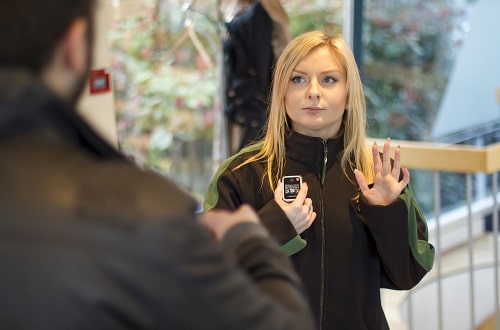New developments in safety helmet technology are helping to protect workers from traumatic brain injuries.
Features
A heads up
When someone suffers a concussion, or even more serious damage to the brain, rotational forces are most likely the cause, yet standard safety helmets (certified to EN397) aren’t designed specifically to protect against this kind of impact. However, the head protection market is now tackling this issue.
Understanding impacts
A rotational brain injury is the result of a rapid change of the rotational velocity of the head. This rapid change can be caused by a direct hit to the safety helmet or the skull or by an indirect hit to the shoulder leading to a rotational motion of the head. Linear acceleration injuries result from straight line forces that compress or stretch the brain within the skull.
 Safety helmets are good at absorbing linear impacts. The problem arises when you have an impact and experience rotational acceleration. Photograph: iStock
Safety helmets are good at absorbing linear impacts. The problem arises when you have an impact and experience rotational acceleration. Photograph: iStock
In contrast, rotational acceleration injuries result from non-linear forces that twist/shear the brain within the skull (see Holburn, A. H. S. (1943). Mechanisms of head injury. Lancet, 245, 438–441). Brain tissue deformation (damage) is mainly caused by shear rather than compression or tension due to its mechanical properties. Therefore, most traumatic brain injuries are caused by rotational acceleration.
Understanding brain injuries
Although linear acceleration injury and rotational acceleration injury can often occur together, there are some important differences. Linear acceleration injury is often associated with focal brain injuries, whereas rotational acceleration injuries more commonly involve both focal and diffuse brain injury.
Focal brain damage occurs from contact injury types resulting in contusion, laceration, and intracranial haemorrhage. On the other hand, diffuse brain damage occurs due to acceleration/deceleration injury types resulting in diffuse axonal injury or brain swelling. The outcome from head injury can vary significantly depending on the type of impact sustained.
Can dropped objects cause a rotational head injury?
To answer this, we need to consider whether an object falls straight down. The answer is no as an object’s descent is usually affected on its way down. Dropped objects include static dropped objects that fall under their own weight (gravity) without any applied force, or dynamic dropped objects that fall from their previous position due to an applied force. For example, a brick falls but hits the scaffolding or re-bounds off some hoarding.
 New developments in safety helmet technology are helping to protect workers from traumatic brain injuries. Photograph: Centurion Safety Products
New developments in safety helmet technology are helping to protect workers from traumatic brain injuries. Photograph: Centurion Safety Products
When a falling object hits someone who is wearing a hard hat, one of three things is likely to happen; the impact will be perpendicular and strike the wearer square on the top of the safety helmet; the hit is dead centre, which means there will be very limited rotational forces (if any) to the head/brain; or the hit is off centre (in any direction), which introduces rotational forces to the head/brain.
What is surprising to many people is that it is almost nine times more common to acquire a long-term injury from a fall than to get the same injury outcome from a falling object. When it comes to falls, wearing a safety helmet does help reduce the impact, and if that safety helmet has a liner inside it might further reduce the chance of injury.
However, the translational acceleration, angular acceleration and angular velocity are normally very high in fall situations and can lead to an increased risk of rotational brain injury since the impact may have been oblique rather than perpendicular or a combination of both.
So, what does this mean for safety helmets?
Safety helmets are relatively good at absorbing linear impacts, as shown by the EN397 impact test. If the safety helmet you are wearing has a liner, then this is improved slightly. The problem arises when you have an impact and experience rotational acceleration.
The helmet then slides across the head grabbing the skull and rotating it along with the directional force of the impact. This can occur not only because of slips, trips and falls from the same level or one level above, but also from strikes from dropped objects. This may also include sideswipes from machinery – say a digger operator turning suddenly and striking you with the bucket.
The solution – redirecting rotational energy
Given the complex nature of rotational injuries, creating head protection that protects against this type of impact is no simple task. However, thankfully it is one that Swedish helmet technology company Mips, who are already well known in the sports industry, have been working on for several years and now their technology is also coming to the safety market. Centurion Safety Products formed a partnership with Mips to develop the world’s first multi-directional impact protection system for an industrial helmet that has a cradle.
For the types of impacts we have been discussing, this can help redirect harmful rotational forces that would otherwise be transferred to the head in the
event of an incident.
Injury statistics show that it is most common to fall at an angle when you fall and hit your head, compared to a linear fall. Falling at an angle creates rotational motion and science has shown that our brains are particularly susceptible to rotational forces. In an angled impact, these forces may transfer to your head. The Mips Low Friction Layer can help redirect rotational forces.
The human brain is amazing but fragile. During an angled impact, rotational motion can cause strain to the brain tissue, which may lead to severe brain injuries. Traumatic brain injury still represents the leading cause of morbidity and mortality in individuals under the age of 45 in the world. When you have suffered a concussion or even more serious damage to the brain, rotational motion to the brain is the most likely cause.
The Mips Low Friction Layer allows the head to move inside the helmet (10 –15 millimetres relative motion in all directions), which can help redirect harmful rotational motion that would otherwise be transferred to the head.
Chris Tidy is Technical and training specialist at Centurion Safety Products
FEATURES

Purchasing body-worn cameras: 10 top tips
By Alasdair Field, Reveal Media on 13 May 2024
Body-worn cameras can reduce the risk of violence and threats to staff by providing a deterrent effect and documentary evidence for pursuing aggressors, but it’s important to carefully consider issues like functionality, data storage and user training during the selection process.

Vulnerable workers: protection is key
By Naz Dossa, Peoplesafe on 13 May 2024
From working alone to commuting after hours, workers can be vulnerable to threats, aggression and harassment – but training and the right technology can help.

AI and worker wellbeing: a new risk for employers
By David Sharp, International Workplace on 10 May 2024
Data generated by machine learning and artificial intelligence at work looks set to play a huge role in boosting both worker health and safety and business productivity, but it’s vital that workers’ data used for algorithmic processing is handled lawfully, fairly and transparently.



